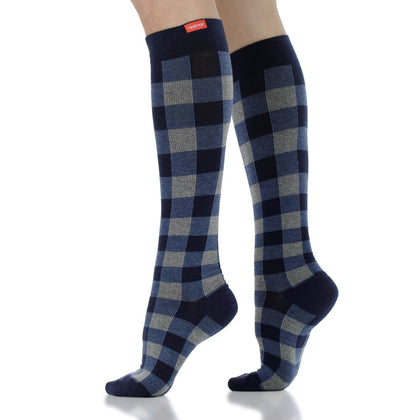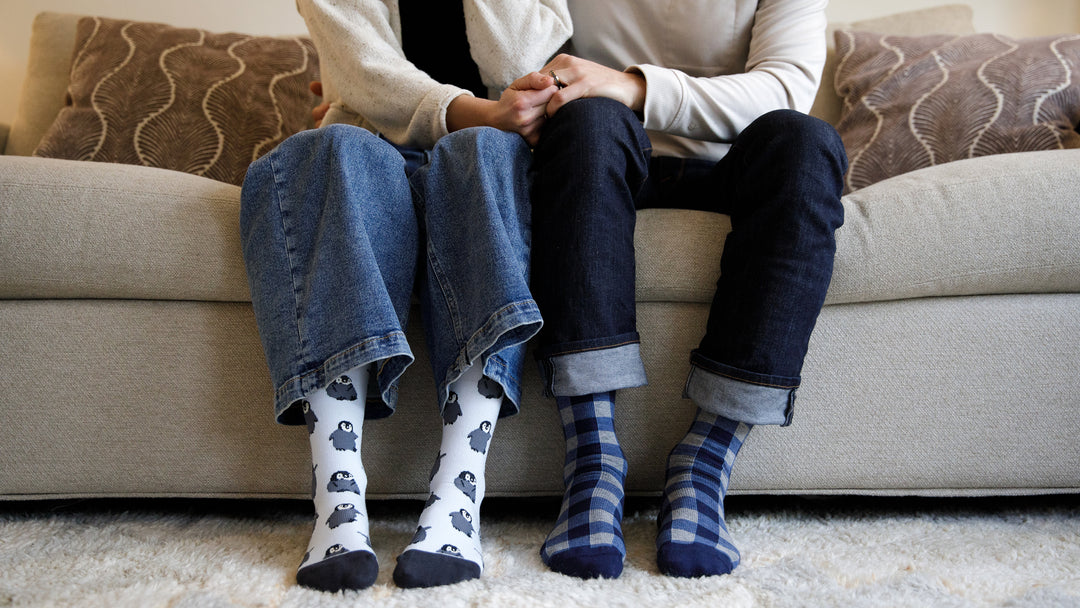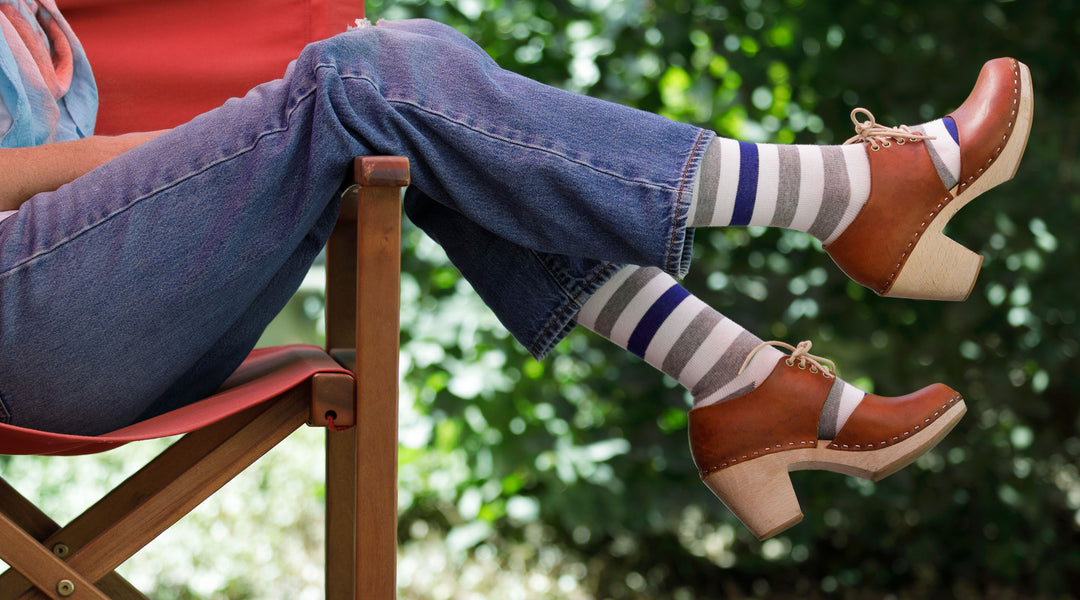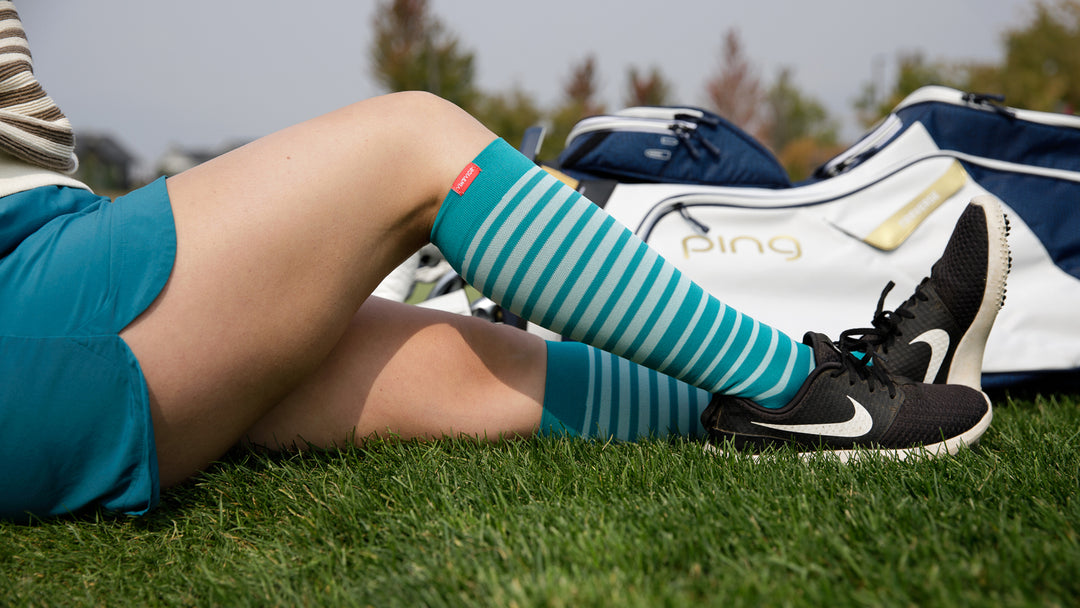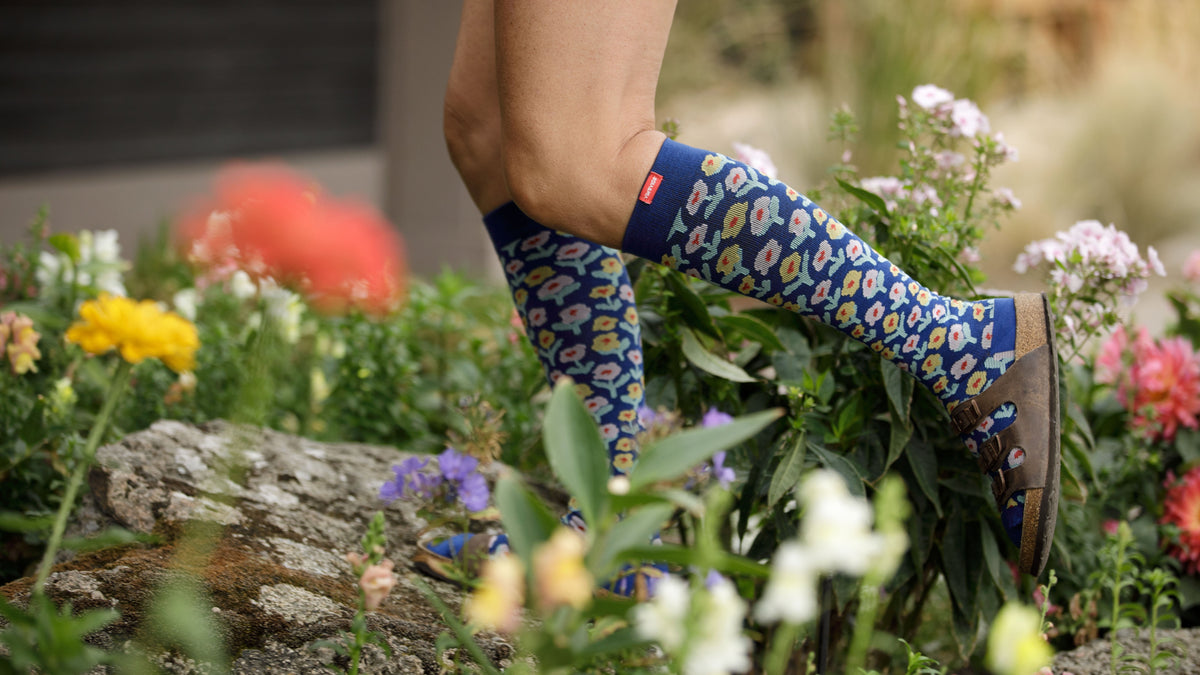

Compression garments apply therapeutic pressure on the body, which stimulates blood and lymph flow while supporting the muscles and joints in the affected area to benefit the body. However, not all compression stockings, sleeves, or socks are the same. The level of compression applied can vary from 15 mmHg (some of the lightest, comfortable for everyday wear) to 30 mmHg and above for medical grade items.
The notation mmHg refers to millimeters of mercury — a common measurement of pressure used in science and medicine. Most compression socks offer the 15-20 mmHg level for casual wear. 20-30 mmHg is a medium compression level which can help if you are working to manage or relieve symptoms from certain medical conditions. Don’t worry, this pressure is sub-diastolic, which means the compression socks will not cut off blood flow—they actually improve it!
Higher pressures are available, but they are often prescribed by a doctor for severe vein or health conditions like chronic venous insufficiency or diabetic neuropathy.
In this article, you will learn what 20-30 mmHg compression means in terms of stockings and socks as well as what you need to know when choosing your next compression garment.
What Does 20-30 mmHg Mean in Compression Stockings?
First, let us understand the term. The “mmHg” you see is the unit of measurement for the therapeutic pressure applied by compression garments. The range starts at about 15 mmHg and can go up to 40 mmHg, which is only available via prescription.
In practical terms, 20-30 mmHg compression means that a medium level of pressure is applied to the limbs. This makes compression socks of this pressure level very effective for countering the effects of edema, deep vein thrombosis, or lymphedema. Vim & Vigr graduated compression socks in 20-30 mmHg are also a great choice for pre- and post-surgical applications, when your doctor recommends compression.
What is the Difference Between 15-20 mmHg and 20-30 mmHg Compression Socks?
The main difference between these two compression levels is how much pressure is applied to the limbs when wearing them:
15-20 mmHg compression socks feel lighter and easier to wear all day long. You will still feel a squeeze on the lower limbs and get the benefit of better circulation. You might even forget you’re wearing compression socks all day at work or during a physical activity!
20-30 mmHg compression socks apply more pressure, which may offer more support to the muscles and joints. They are better suited for individuals with specific medical conditions who need a boost in blood flow. They are also recommended for preventing deep vein thrombosis and supporting recovery in people that had surgery, among others.

Benefits of 20-30 mmHg Compression
Whether you go for 20-30 mmHg compression socks because of a medical condition or after an injury, you will get the benefit of better blood flow, reduced swelling and inflammation, and reduced recovery periods.
Supports Healthy Circulation
Better blood flow is one of the key benefits of wearing compression socks. A 2012 paper in the Annals of Vascular Diseases documented the beneficial role of wearing compression socks with a pressure of about 20 mmHg. The researchers found that compression socks increase the speed of circulation while lying down and prevent swelling after prolonged sitting and standing.
Compression is seen as a cornerstone in the management of venous and lymphatic insufficiency. It can help with lymphatic drainage and will support a healthy circulation, particularly if you are suffering from, or at risk of, blood clots and varicose veins. The higher compression level of 20-30 mmHg is firmer, which stimulates venous return more and takes the pressure off the lower leg veins when they have been weakened by illness.
Reduces Swelling and Fatigue
Compression socks support healthy blood flow and lymphatic drainage. With Vim & Vigr graduated compression stockings in 20-30 mmHg, you can reduce fluid buildup in the lower legs, especially when sitting or standing for long periods of time. Additionally, these garments provide a light massage of the lower limbs, which provides relief from pain and swelling to help you feel re-energized.
Instead of suffering from heavy, painful lower legs, wear 20-30 mmHg compression socks to help you fight off fatigue and enjoy your favorite leisure activities or simply relax while putting your feet up.
Aides in Recovery and Injury Prevention
The improvement in blood flow to the lower legs and back to the heart is key for bringing nutrients and oxygen to the limbs. This helps nourish the muscles, repairing them after a hard effort and reducing the time it takes to recover after workouts. Various studies show that recovery from exercise induced muscle damage is enhanced thanks to compression legwear.
In the same way, when recovering from an injury, increased blood flow and support of the tendons and muscles are made easier by wearing compression socks. You should consult with your doctor to see whether 20-30 mmHg compression may be more helpful for your injury recovery than the lower 15-20 mmHg.
Finally, many athletes use graduated compression socks to limit the chance of injury when exercising. Especially when you’re just back from a sprained ankle or Achilles tendonitis, supporting the lower limbs gives you added stability and reassurance, while also continuing to stimulate blood flow and bring down inflammation and swelling.

Who Should Choose 20-30 mmHg Compression?
A compression level of 20-30 mmHg is firmer, more supportive, and therefore more adapted to those who have a higher need for a boost in blood flow or for help recovering from an injury. Here are the cases where 20-30 mmHg graduated compression socks could be best for you.
People Who Sit or Stand All Day
If your job requires you to spend a lot of time on your feet, your lower leg veins are continually fighting gravity. As a result, there is a higher risk of swelling, blood pooling at the extremities, and general discomfort. Additionally, if you already have circulation problems, then the casual 15-20 mmHg compression socks may offer some relief, but perhaps not enough. The same happens when you sit down and don’t move around much — your lower legs are subjected to gravity and compressed veins from sitting to cause fluid build-up.
The Vim & Vigr 20-30 mmHg graduated compression socks boost local circulation, which stimulates venous return to the heart thanks to their design. Additionally, they support the joints and lower leg muscles, providing a gentle and comforting massage as you wear them. Say hello to no more fluid build-up and more energized legs!

Travelers
Traveling on economy class airplanes, on trains, or even in your car for hours can take its toll on your circulation to make your legs really uncomfortable when you reach your destination. This is because sitting for long periods of time without moving the legs leads to blood pooling at the extremities, which in turn causes swelling and pain. Medical research has also shown that compression socks reduce the chance of you developing vein problems from flights. One solution is to add some movement and stretching into your journey, taking breaks from driving, or getting up from your seat regularly on a plane.
However, if you also have poor circulation or other medical conditions, you will need a little more help. Graduated compression socks in 20-30 mmHg pressure level massage the lower legs, boost upwards blood flow, and prevent blood from pooling around your ankles. Wear them while also doing some stretches and taking walking breaks, and you’ll feel so much better.
Fitness Enthusiasts and Athletes
Because compression socks help improve circulation, they are also beneficial for athletes and workout enthusiasts in general. The increase in blood flow also delivers oxygen and nutrients to muscles more efficiently, which might help them recover and rebuild after hard exercise. Even for insufficiently active adults, studies show that wearing compression socks for recovery reduces the time it takes before you feel able to exercise again, removing a barrier for sticking to exercise.
Additionally, because of the support and massage they provide to the lower legs, knee-high graduated compression socks are favored by triathletes, cyclists, and runners, as they support key areas prone to injury, like the calf muscles and the Achilles tendons. Compression legwear is great for wearing when you return to exercise after an injury, thanks to their support of muscles and joints and to reducing some of the pressure on the lower legs.
While in most cases, 15-20 mmHg compression socks may be enough, endurance athletes, those returning from injury, or fitness enthusiasts with poor circulation will get better support from 20-30 mmHg compression socks.
Those with Certain Medical Conditions
If you suffer from moderate edema, heat edema or lymphedema, 20-30 mmHg compression socks will be more effective at massaging your legs, supporting fluid movement, and preventing the swelling. Doctors also recommend this level of increased compression to people with deep vein thrombosis (DVT) and moderate spider and varicose veins. Finally, you should consult with your doctor to see if Vim & Vigr 20-30 mmHg compression socks are a good option for you before or after surgery.

Anyone Looking for Everyday Support
If you’re already familiar with 15-20 mmHg compression, you may want to try something firmer for your travels, everyday support, or for recovery after a hot day out or a big workout. When the entry-level compression support doesn’t feel like it delivers enough benefits anymore, trying out the 20-30 mmHg category can be beneficial. Just like with more casual compression, start off by wearing your firmer compression socks for a short amount of time, get used to them, then increase the time you wear them gradually as you get more comfortable.
Choosing the Right 20-30 mmHg Compression Option
When you’re ready to level up to 20-30 mmHg compression socks, here is what you need to know to find the perfect pair.
Matching Fabric to Lifestyle
What you do when you wear your Vim & Vigr compression socks matters. Some fabrics are designed to be more moisture-wicking or breathable, while others may look great, but not deliver the comfort levels you need for certain activities:
Cotton is great for everyday wear such as at work or when traveling long distances. It’s soft and flexible, but won’t wick away moisture so well and can lead to sweaty feet in hot conditions.
Nylon socks are extremely versatile and flexible, great for wearing when you work out. You can go for moisture-wicking nylon to keep feet dry and sweat-free, or you can also choose the special Vim & Vigr choice nylon compression socks, where we’ve removed seams to protect you from blisters and discomfort.
Merino wool is ideal for temperature regulation, as the fabric absorbs moisture and lets the skin breathe, allowing air to circulate and keeping feet cool in the heat and warm in cold conditions. Wear them for hiking, long days outdoors, or a cozy night in.
Exploring Different Styles to Suit Your Needs
You may think that wearing 20-30 mmHg compression socks restricts you to the classic knee-high, closed toe design. Not true! There are many different options to suit your activity, outfit, or personalized needs:
Open-toe compression socks also come in 20-30 mmHg pressure level, allowing you to wear sandals or flip flops while still benefiting from a circulation boost.
Compression tights allow you full coverage for when you’re colder or want to support your blood flow and muscles all the way up to your waistline. They are also ideal for making up lots of cute outfits.
Finding the Right Size and Fit
Concerned about finding the best fitting compression socks in 20-30 mmHg pressure level, without going too tight or too loose? The tricky thing about compression is that it may initially feel very restrictive, but the increased level of therapeutic pressure on your legs will become familiar with time. You just need to follow our sizing guidelines, measuring your calf circumference and matching that to your shoe size. If your socks feel too tight at the start, wear them for a shorter period, gradually increasing this as you become more familiar with the sensation of 20-30 mmHg compression.
Increasing the level of compression for your socks can be extremely beneficial if you struggle with circulation, lymphatic drainage, or muscle strains. You can improve your blood flow, feel more energized and lighter, and reduce muscle soreness more quickly. The key is to adapt to your 20-30 mmHg compression socks gradually and to always consult with a medical professional if you have any doubts or questions about a medical condition.
Browse all 20-30 mmHg compression socks to find the perfect design for you:
References
Charles, T., Mackintosh, D., Healy, B., Perrin, K., Weatherall, M., & Beasley, R. (2011). Merino wool graduated compression stocking increases lower limb venous blood flow: a randomized controlled trial. Advances in therapy, 28(3), 227–237. Read it here.
Clarke, M. J., Broderick, C., Hopewell, S., Juszczak, E., & Eisinga, A. (2016). Compression stockings for preventing deep vein thrombosis in airline passengers. The Cochrane database of systematic reviews, 9(9), CD004002. Read it here.
Felty, C. L., & Rooke, T. W. (2005). Compression therapy for chronic venous insufficiency. Seminars in vascular surgery, 18(1), 36–40. Read it here.
Marqués-Jiménez, D., Calleja-González, J., Arratibel, I., Delextrat, A., & Terrados, N. (2016). Are compression garments effective for the recovery of exercise-induced muscle damage? A systematic review with meta-analysis. Physiology & behavior, 153, 133–148. Read it here.
Montoye, A. H. K., Mithen, A. A., Westra, H. L., Besteman, S. S., & Rider, B. C. (2021). The Effect of Compression Socks on Maximal Exercise Performance and Recovery in Insufficiently Active Adults. International journal of exercise science, 14(7), 1036–1051. Read it here.
Mosti, G., Picerni, P., & Partsch, H. (2012). Compression stockings with moderate pressure are able to reduce chronic leg oedema. Phlebology, 27(6), 289–296. Read it here.
Partsch H. (2012). Compression therapy: clinical and experimental evidence. Annals of vascular diseases, 5(4), 416–422. Read it here.
Phillips, S. M., Gallagher, M., & Buchan, H. (2008). Use graduated compression stockings postoperatively to prevent deep vein thrombosis. BMJ (Clinical research ed.), 336(7650), 943–944. Read it here.
Rother, U., Grussler, A., Griesbach, C., Almasi-Sperling, V., Lang, W., & Meyer, A. (2020). Safety of medical compression stockings in patients with diabetes mellitus or peripheral arterial disease. BMJ open diabetes research & care, 8(1), e001316. Read it here.
Sachdeva, A., Dalton, M., & Lees, T. (2018). Graduated compression stockings for prevention of deep vein thrombosis. The Cochrane database of systematic reviews, 11(11), CD001484. Read it here.
Shahoud, J.S., Sanvictores, T., & Aeddula, N.R. (2023). Physiology, Arterial Pressure Regulation. Treasure Island (FL): StatPearls Publishing; 2025 Jan. Read it here.








